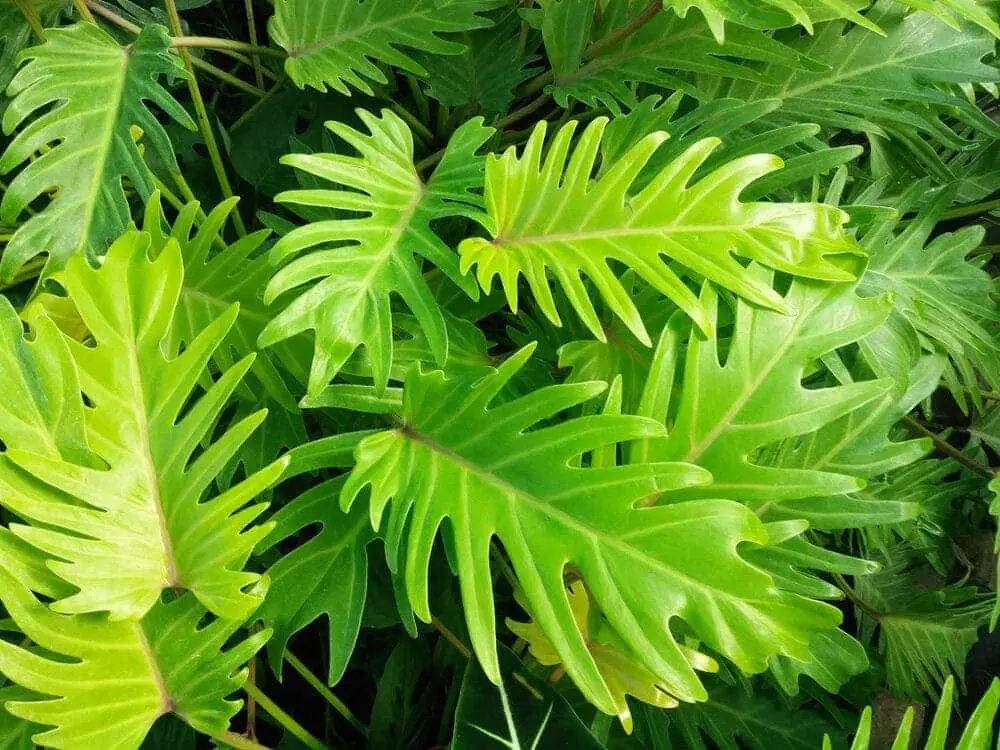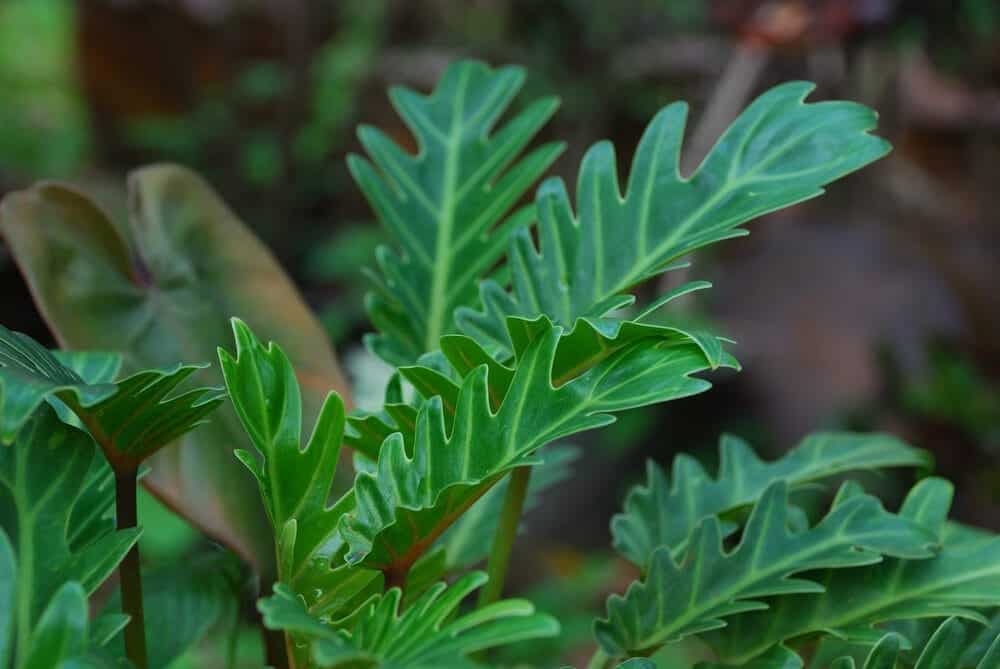The Philodendron Xanadu is an easy plant to grow. It makes a great vertical accent to your home.
It is also called Winterbourn and is a member of the Philodendron genus. It is a vining plant that needs no support as it is not a climber but more of a bushy plant. Because of its compact, dense shape, it makes a great houseplant.
Philodendron Xanadu Care & Growing Guide
1. Light Requirement
The Philodendron Xanadu is different from other Philodendron in that it likes a little more light to maintain its compact growth. The best light would be indirect, bright light. It can even use a little direct sun in the morning. If you do not give it enough light, the stems will start to elongate too much. If you have it in too much sunlight, the foliage can turn a yellowish-green color.
2. Water
Water it thoroughly and let the access drain through the holes in the bottom of the planter. When you see the water starting to come from the drain holes, you will know you have watered it enough. Before you water it again, let the Philodendron Xanadu dry out about half. It likes to be moist but not soaking wet. If you are unsure if it is ready to be watered, stick your finger in the soil to see if it is moist. If you can feel any moisture, you should wait a few days before you check again.
3. Climate
USDA Hardiness Zone 9-11
4. Soil
You should plant a Philodendron Xanadu using a combination of organic peat moss or topsoil that is mixed with composted cow manure. During the growing season, you should be sure to fertilize your Philodendron Xanadu with one that contains all the major micro-and macronutrients to give your plant what it needs to grow. You should fertilize it three times a year; spring, summer, and fall.
These nutrients are generally found in the soil or plant. The soil may be depleted of these nutrients so that is why you should use a fertilizer with them in it. Micro-nutrients can include manganese, zinc, iron, and copper. The macro-nutrients can include sulfur, nitrogen, calcium, potassium, phosphorus, and magnesium,
5. Temperature
The ideal growing temperature for this plant should be 75-85 degrees Fahrenheit during the day. At night, the temperatures should be between 65-70 degrees Fahrenheit. The Philodendron Xanadu likes high humidity but can tolerate the average humidity in a home. If you want to increase the amount of humidity that your plant receives, you can make a pebble tray.
Lay pebbles on a tray and cover with water. You put your planter on the pebbles on the tray but do not sit the planter in the water. As the water evaporates, it will create the humidity that the Philodendron Xanadu needs. Just add water to the tray when needed.

6. Repotting
Many will repot the plant when they want shoots to start new plants or the plant has gotten so big it needs to be divided. Remove the plant from the pot very gently and separate the root ball into sections. Generally, you will have to slice the root ball but you can try to untangle the roots if you want. After the root ball has been separated, just repot each one into the right sized pots and care for them as you have done before.
7. Speed of Growth
The Philodendron Xanadu is a plant that grows at a moderate pace
8. Height and Spread
The Philodendron Xanadu will grow more wide than tall with a width of four to six feet, and a height of two to four feet tall. When growing indoors, it will be on the shorter end, around two feet tall and four feet wide
9. Flowers
The Philodendron Xanadu does not produce flowers but does have large leathery green leaves that expand up to 18 x 14 inches.
10. Trimming
The Philodendron Xanadu rarely needs to be trimmed as with its clumping growth pattern; it forms an attractive cushion shape all on its own. You may need to remove any dead or damaged leaves at the base of the stem. This is done to keep your Philodendron Xanadu looking nice.

Is Philodendron Xanadu Poisonous?
Yes, they are poisonous to animals and humans if some parts are ingested.
Can Philodendron Xanadu grow in Water?
No, you cannot grow them in water.
How to Get Philodendron Xanadu to Flower?
They do not have flowers.
Also read: Celosia Plant (Cockscomb) Care & Growing Guide
Common Philodendron Xanadu Plant Diseases
Philodendron Xanadu is prone to a variety of diseases, including:
- Yellowing of the leaves—this is the sign that you are keeping the water too wet so you need to give it less water.
- Foliage is a yellowish-green—too much direct sun.
- Spider mites—these can happen if your Philodendron Xanadu is not getting enough humidity. You can get rid of them by spraying the leaves with a soapy water mixture or Neem oil spray.
- Leaf spot—this causes brown spots on the foliage that vary in size and shape. It is a fungus that is feeding on the plant. To help prevent this make sure that your plant has plenty of room for the air to circulate around the plant. You should also water the plant at the soil level to prevent the leaves from getting too wet.
Keep reading:
Conclusion
- The Philodendron Xanadu is naturally mounded and looks like a pillow of a plant.
- They are great if planted alone or they can be a companion plant to highlight other, more colorful tropical plants.
- It is a deer-resistant plant and most bugs do not like it either.
- When you live in a warm climate where you can plant them outdoors, you need to plant them three feet apart as they need room to fill out and allow the air to circulate so they do not stay too wet.
- When planting them as an indoor plant, you should use a three-gallon pot to start with and repot it when it outgrows the pot.
- Planted outdoors, the Philodendron Xanadu can be used to line a drive or walkway, along the edge of a deck, foundation plant, and more.
- The Philodendron Xanadu is one of about 450 species of this genus of plant.

Victoria is the owner and main author of hobby plants. She loves spending her free time in her garden planting and taking care of her plants. Victoria hopes you enjoy the content here!
![Queen Of The Night Flower [Complete Plant Care Guide] Queen Of The Night Flower [Complete Plant Care Guide]](https://www.hobbyplants.com/wp-content/uploads/2022/07/queen-of-the-night-flower-300x158.jpg)
![Mother Of Thousands Plant [Complete Plant Care Guide] Mother Of Thousands Plant [Complete Plant Care Guide]](https://www.hobbyplants.com/wp-content/uploads/2022/07/mother-of-thousands-plant-300x158.jpg)
![How Often Should You Water Pothos? [Complete Care Guide] How Often Should You Water Pothos? [Complete Care Guide]](https://www.hobbyplants.com/wp-content/uploads/2022/07/how-often-to-water-pothos-300x158.jpg)
![Can Snake Plants Live Outside? [COMPLETE CARE GUIDE] Can Snake Plants Live Outside? [COMPLETE CARE GUIDE]](https://www.hobbyplants.com/wp-content/uploads/2022/08/can-snake-plants-live-outside-300x158.jpg)
![Majesty Palm Plant Care: [Complete Beginner's Guide] Majesty Palm Plant Care: [Complete Beginner's Guide]](https://www.hobbyplants.com/wp-content/uploads/2022/08/majesty-palm-care-300x158.jpg)
![Exotic Angel Plant Care: [Complete Beginner's Guide] Exotic Angel Plant Care: [Complete Beginner's Guide]](https://www.hobbyplants.com/wp-content/uploads/2022/08/exotic-angel-plant-care-300x158.jpg)
![Do Coleus Like Sun Or Shade: [Complete Care Guide] Do Coleus Like Sun Or Shade: [Complete Care Guide]](https://www.hobbyplants.com/wp-content/uploads/2022/08/coleus-sun-or-shade-300x158.jpg)
![Snow White Waffle Plant: [Complete Care Guide] Snow White Waffle Plant: [Complete Care Guide]](https://www.hobbyplants.com/wp-content/uploads/2022/08/snow-white-waffle-plant-300x158.jpg)
![Waffle Plant Care: [Complete Beginner's Guide] Waffle Plant Care: [Complete Beginner's Guide]](https://www.hobbyplants.com/wp-content/uploads/2022/08/waffle-plant-300x158.jpg)
![Bird Of Paradise Plant Care: [Complete Beginner's Guide] Bird Of Paradise Plant Care: [Complete Beginner's Guide]](https://www.hobbyplants.com/wp-content/uploads/2022/08/bird-of-paradise-plant-300x158.jpg)
![Purple Passion Plant Care: [Complete Beginner's Guide] Purple Passion Plant Care: [Complete Beginner's Guide]](https://www.hobbyplants.com/wp-content/uploads/2022/08/purple-passion-plant-care-300x158.jpg)
![China Doll Plant Care: [Complete Beginner's Guide] China Doll Plant Care: [Complete Beginner's Guide]](https://www.hobbyplants.com/wp-content/uploads/2022/09/china-doll-plant-care-300x158.jpg)